Intelligence service. Information about the German troops in 1938 and in 1940
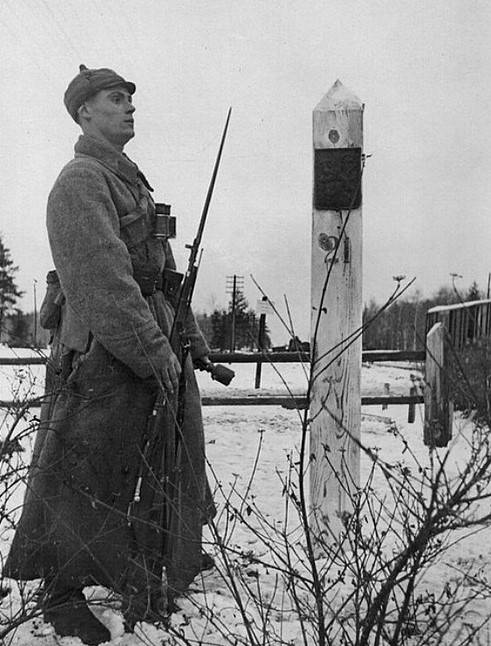
In this part, let's go back a little. Recently, the Ministry of Defense of the Russian Federation declassified several documents that were developed in the 1938 year. The consideration of the Republic of Moldova for the period from 1938 to 22.6.41 will allow us to get an idea of the reliability of the materials that our intelligence extracted in different periods before the war. Can we find a connection between the information supplied by our intelligence, between the documents developed by the General Staff of the KA, between the actions of the leaders of the Soviet Union and the Red Army?
In several subsequent parts, the author decided to examine in more detail the events of 1940 and the beginning of 1941. Information about these events will be supplemented by material from additional literature. This is due to small inaccuracies that occurred in the two previous parts. The author decided to somewhat expand the scope of the article, considering not only the Republic of Moldova, but also to propose a version of the appearance of some documents at the headquarters of the spacecraft, which allow to explain the actions of the leaders of the USSR and the spacecraft on the eve of the war. The materials prepared by the author will be supplemented by materials from the book of B. Müller-Hillebrand, "German Army 1933-1945." And from the diary of the former Chief of the General Staff of the German Army F. Halder.
The following abbreviations will be used in the article: А - field army AK - army corps, IN - military district, for - Landwehr Division, cd (kn) - cavalry division (regiment), ld - light division, md - motorized division, pd (pp) - infantry division (regiment), td (mn) - tank division (regiment).
The number of German tanks in the documents
Recently, the Russian Ministry of Defense published Note Chief of the General Staff of the Red Army B.M. Shaposhnikova narcotics defense K.E. Voroshilov from 24.3.38, "On the most likely opponents of the USSR." The text of the Note was previously available in the A.N. Yakovleva. The Note provides an estimate of the number of divisions in the German armed forces: "... 96 pd, 5 cd, 5 md, 30 tank.b ...".
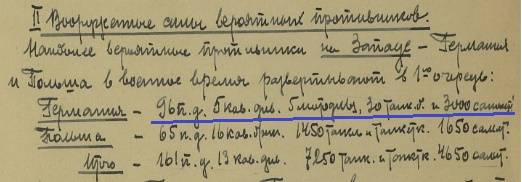
The document clearly speaks of the 30 tank battalions, since the next page talks about the direction of Germany’s troops against 2 / 3 against our country. Among the enumerations of these troops, 20 tank battalions are mentioned.

In the Note, the number of German tanks and wedges is estimated by the number 5800. Such a number of tanks and wedges in the German troops was not even in 22.6.41, and this is taking into account the presence of Czechoslovak and French captured tanks in the German tank forces, as well as the work of industry in Germany and the occupied countries of Europe over the next three years. Therefore, the information about the tanks, which is given in the Note, is very high. The overly overestimated idea of intelligence about production and the presence of tanks in the German armed forces continued until the outbreak of war in 1941.
Special message Reconnaissance of the General Staff of the spacecraft 11.3.41:
Bearing in mind the possibility of rapidly deploying tank production on the basis of existing automotive tractor factories (up to 15-20 plants), as well as increasing the production of tanks at plants with their established production, we can assume that Germany will be able to produce up to 18-20 thousand tanks a year. With the use of French tank factories located in the occupied zone, Germany will be able to additionally receive up to 10000 tanks per year...
In fact, in Germany before 1937, 1876 tanks and wedges were produced. From 1938 to 1940, another 3006 tanks were produced. Throughout the entire 1941 year, another 3153 tank was produced. Analyzing the Republic of Moldova, the leadership of the spacecraft and the Soviet Union also sought to produce as many modern tanks as possible. It is possible that the number of tanks was preferred over their quality ...
Based on the Republic of Moldova, the number of tanks in the German army was also overestimated in the General Staff of the spacecraft. Plan of the General Staff of the Spacecraft on the strategic deployment of the Armed Forces of the Soviet Union in the West and East (11.3.41):
At 22.6.41 the tanks in the German forces were a little more than 3 thousand.
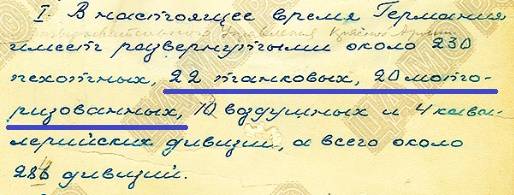
Intelligence report No. 5 (in the West) of the Intelligence Directorate of the General Staff of the KA:
RM about the total number of divisions were overstated: 11.3.41 by 26%, 15.5.41 by 36% and 1.6.41 by 37-41%. In total there were 209,5 divisions. At 22.6.41, the total number of motorized divisions and individual regiments was actually 15,2.
At the same time, information about tank divisions turned out to be fairly accurate: on June 22, in fact, there were 21, etc. However, the number of tanks in twenty-one divisions and in a small number of individual tank regiments and battalions three times overpriced! Since intelligence did not find most of the tank divisions, the number of tanks at the border should have corresponded significantly less than 10 thousand ...
Since the data on the German tank forces in Germany are severely distorted, it is proposed that the number of German divisions that existed in the 1938 year of the 30 tank battalions be disregarded. In principle, 30 tank battalions are not so many: only about 7,5 etc. At that time, the German TD consisted of a tank brigade, which included two military units, two battalions each.
Number of German divisions in 1938
Below are data on the increase in the number of divisions of the German army.
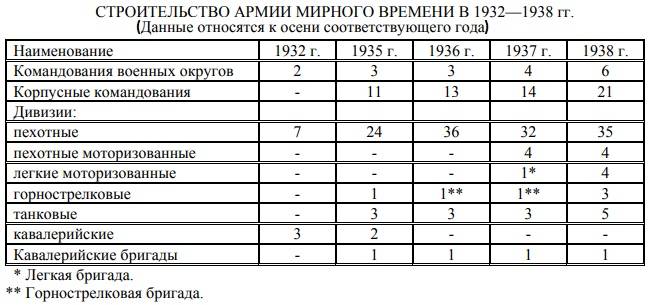
In addition to the field troops indicated in the figure, there were 21 dLs that were intended for the defense of cities, border and fortified areas. These divisions had limited mobility and were equipped with military servicemen from 35 to 45 of summer age. Those liable for these divisions underwent military training in the 1918 year and earlier. In dl supplied obsolete weapons, withdrawn from the armament of the army. According to some reports, these divisions (except for the 14-th DL) have never been fully deployed. In the spring of 1940, the formation of several infantry divisions (with three hundred numbers) began on the basis of these divisions.

In case of mobilization, 4 reserve divisions were to be formed. These divisions in their structure corresponded to infantry divisions, but had fewer weapons and vehicles. The bulk of the personnel of the reserve divisions was staffed by the reservists of the 1 and 2 categories, and if there were a shortage of them, they were from the Landver.
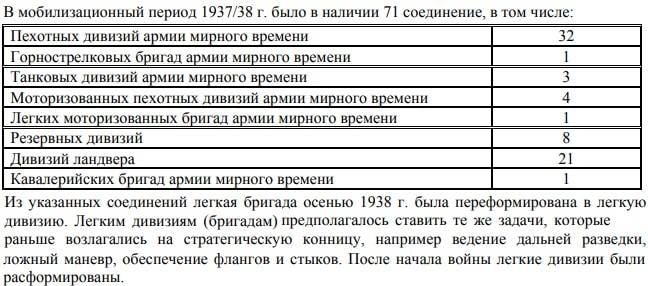
According to B. Müller-Hillebrand, in the autumn of the 1938 of the year, the Wehrmacht had up to 69,5 divisions. German troops are described fairly well in the article "The German Army in September 1938 g ..." . The article material is cross-checked and presented in the form of tables below.
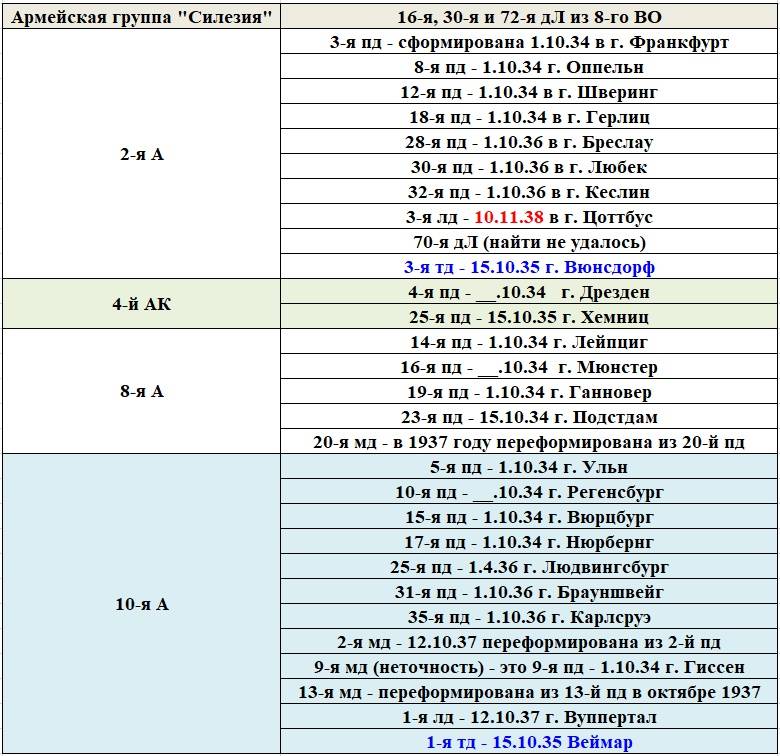
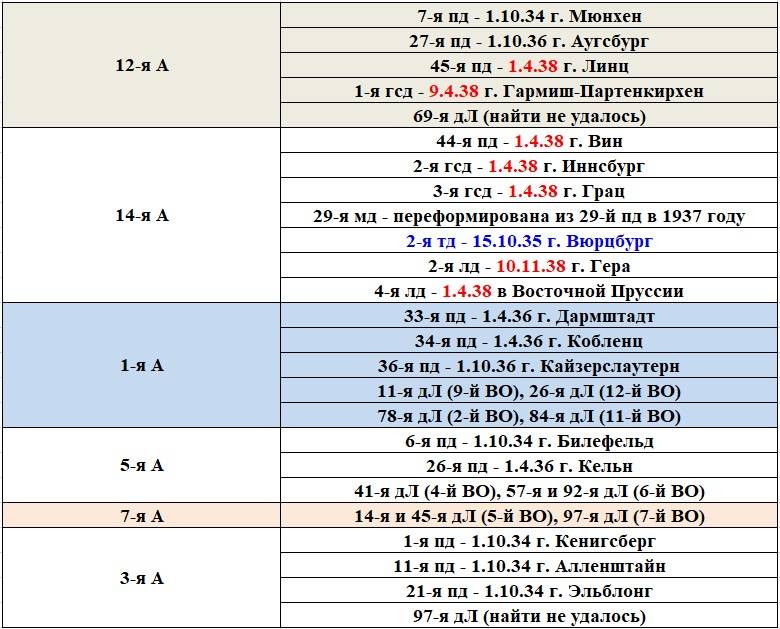

Could not find 61, 69, and 70 dL. At the same time, in the 1th Military District (East Prussia) there were 3-I, 22-I and 67-I DL not mentioned in the article. It is possible that there is an inaccuracy in the article.
9-md was absent in the Wehrmacht. It should be about the 9-th front formed in the 1934 year in the city of Hesse.
Failed to find five reserve divisions - perhaps the author of the article looked for them better. According to B. Muller-Gillebrand, we can talk about eight reserve divisions.
The tables do not show: 5 Id formed by 18.10.38 in the city of Oppeln and 46 Id formed by 24.11.38 in the city of Carlsbad. The author of the article also wrote about these divisions.
Thus, by 24.3.38 in the Wehrmacht there were only 66 divisions that could theoretically be deployed at the front. Excluding td - 63 divisions. The Note by the Chief of the General Staff of the Red Army says 106 divisions that also do not take into account so on.
What conclusions should be made?
1) Intelligence significantly overestimates the number of divisions - by 68% (according to Mueller-Hillebrand - by 61%).
2) The intelligence information does not say about larger formations of tank troops - about tank divisions.
3) Intelligence counted five MD, although there were four.
4) Intelligence counted five cd. In Germany, there was only one cavalry brigade during this period. At the same time, there are four ld. Three of these divisions have two infantry regiments and one motorized reconnaissance and artillery regiments each. 1-I LD has TP, CP, motorized reconnaissance regiment and artillery regiment.
We can assume that the intelligence correctly estimated the number of MD and CD (inaccuracy of information about 25%).
We can assume that intelligence could not track changes in the structure of German troops. You cannot equate infantry divisions and landver divisions. Failed to track the creation of td and ld.
Army Group Vostok May – June 1940
Back in 1936-37. The Vostok border guard was replaced by a border guard capable of only garrison service and lacking artillery. The regiments of the border guards had three battalions of riflemen and one machine-gun company. The regiment was armed with three field guns and two mortars. Along the Eastern border there were about 25 border guard regiments, which were part of nine Border Guard commands.
6.10.39 g. On the basis of the above commands were created commanders: zbV XXXI (since 3.40 in Denmark), zbV XXXII (before 14.5.40 in Poland), zbV XXXIII (from 12.39 - in the Netherlands), zbV XXXIV (before the war in Poland), zbV XXXV (before the war in Poland), zbV XXXVI (11.5.40 g. In France). On the basis of three commands (8 regiments), three infantry divisions were formed (521-I, 526-I and 537-I). 521-I PD 18.3.40 began the reorganization in the 395 th. 526-I PD 28.5.40 g. Was relocated to the 6-th VO and 15.12.41 g. Disbanded. 537-I PD - 9.12.40 was disbanded
By early June 1940 For two years, in two military commanders, there were about seven former border regiments and two front-line regiments (395 and 537-back), formed on the basis of border regiments.
In addition, by the beginning of June, newly formed infantry divisions were located on the territory of East Prussia and Poland: 311-I, 351-I, 358-I, 365-I, 379-I, 386-I, 393-I and 399-I. It is possible that until June in the indicated territory there were the 206-I and 213-I fronts. 209-I was until July 1940 year. Total total up to 13 divisions excluding parts zbV XXXIV and zbV XXXV. The data presented do not differ much from the Muller-Hillebrand data on ten divisions in the East.
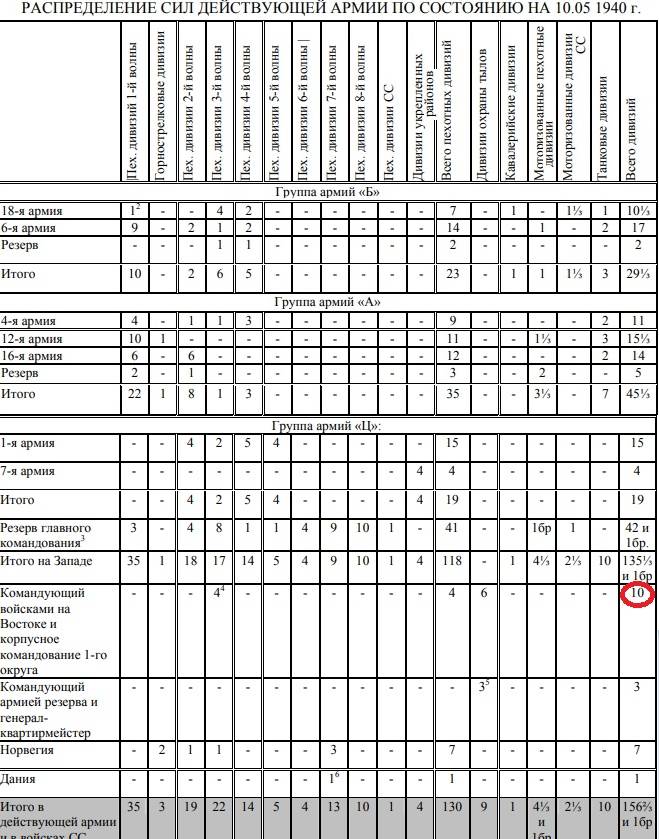
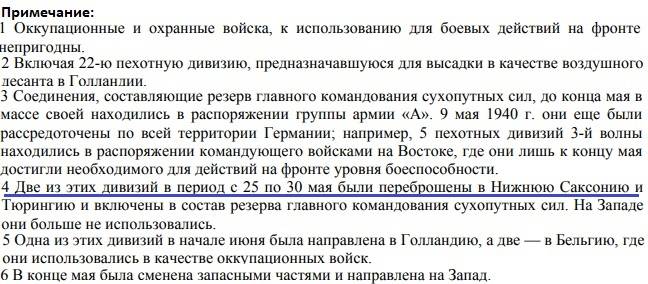
It should be noted that the note 1 applies only to the period May - Summer 1940 of the year. In 22.6.41, part of the security divisions were located near the border and participated in the invasion of our territory in the first echelon.
In June 1940 of the year from East Prussia and Poland five traffic units (206-I (6.40), 213-I (6.40), 311-I (9.6.40), 351-I (1.6.40) and 358 -th (1.6.40 g.)). According to the author, in the East there remain 8 divisions. According to Müller-Hillebrand, there were 9.6.41 SDs at 7 in the East.
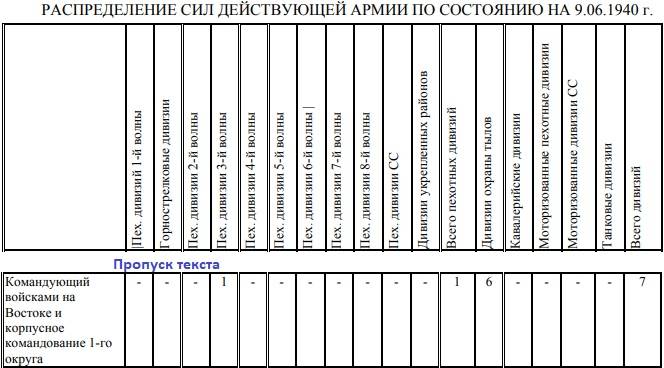
In the figure, the only of the divisions of the 3 wave is the 209 I, which declined at the end of June - July of the 1940 year. The difference in the total number of divisions may be due to the disregard for the 311 th front, which began the redeployment of 9 in June. With the redeployment of 311, the East will remain in the East only six divisions!
Halder 28.5.40 Mr. noted in the diary: “... Six divisions will remain in the East ... In addition, two reserve divisions ...” The number of divisions indicated in the diary coincides with the data provided by the author.
In the spring of 1940, two artillery divisions (from the 3's available) were sent to the West from the rear guard divisions. Six rear security divisions had limited mobility due to a lack of road and horse-drawn vehicles.
Two questions for which there are no documented answers. Was the German command so trusting in the government of the USSR and was not afraid of a blow to the back, having begun the rout of the Anglo-French troops? Was the Red Army so weak that the German command was not afraid of it?
According to the author, Hitler was not afraid of a stab in the back from the Soviet Union. At the same time, the German command very successfully carried out work to misinform our intelligence. According to the 5-th Office of the Red Army as of 15.6.40 in East Prussia and Poland was up to 27 Error in RM is 78%!
Memoirs of General G. Blumentrit:
In the diary of Helder 15.10.40, it is recorded:
The Soviet Union did not want to start a war with Germany. The war between Germany and the USSR was the result of Germany’s positional impasse in the war with England and Hitler’s confidence in his army. Some German generals wrote in their memoirs that the British should be attacked in the Mediterranean Sea, on the North coast of Africa and to continue the subsequent attack on other colonies of England ...
According to Müller-Hillebrand, as of May 1940 there were 4 Army Group Headquarters (“A”, “B”, “Ts” and the headquarters of the commander of troops in the East), 9 Army Headquarters (1, 2, 4, 6, 7, 9 (since 15.5.40), 12, 16 and 18) and 28 Hull Headquarters with headquarters units. Before the relocation of the command of Army Group B to the East, the German command considered the headquarters of the Eastern Group the command of the Army Group. There was not a single army headquarters subordinate to the headquarters of the Eastern Group, which made this command of the army group purely nominal. But intelligence could rightly take him for the headquarters of an army group. The commander of the troops in the East from 15.5.40 was the cavalry general von Ginant.
According to the author, in the West and in Germany there were 32 AKs: from 1 to 19, from 22 to 27, 30, from 38 to 42 and 44. In May, the formation of the 29th AK began. It was not possible to find a single AK headquarters (existing or emerging) in East Prussia and Poland.
Point of non-return
In June 1940, after the defeat of the Anglo-French army, German troops stopped in front of the largest "channel" - the English Channel. Almost the entire German army is concentrated in the West and in Germany. Through its intelligence, the British government was supposed to freeze in horror and begin to probe the situation for peace. But this does not happen.
1.7.40 Mr. Halder will write in his diary:
It turns out that by 1 July, Hitler did not give instructions on the preparation of the landing operation on the territory of England. Perhaps there was an attempt at peace talks by Germany ... From the 1 of July in the troops and at the headquarters the elaboration of plans and measures for the implementation of the landing operation begins.
On 3.7.40, the following entry appears regarding plans for war with the USSR:
The positional impasse and the lack of incitement on the part of the British to conclude peace leads to the fact that at the headquarters of the German ground forces on July 4 the question of the relocation of the 18 army to the East is being considered. On the same day, the head of the Foreign Armies-East department made a report that served as the basis for preparing a plan of war with the Soviet Union. The report made a mistake in underestimating the size of the spacecraft and the rearmament that began.
13.7.40 Mr. Halder writes in his diary:
16.7.40. Hitler issued Directive No. 16, "On the Preparation of the Landing Operation Against England." In a week, the Führer will be informed about the big problems associated with the landing operation ...
22.7.40 Mr. Halder writes:
The reaction to the proposal of peace: the press first took a sharply negative position, then somewhat softened the tone ...
News from England. The situation is assessed as hopeless. The British ambassador in Washington said: England lost the war, She must pay, but do nothing that detracts from her honor and dignity ...
Russian problem will be resolved by offensive. A plan for the upcoming operation should be considered. To defeat the Russian ground army, or at least occupy such territory that it would be possible to secure Berlin and the Silesian industrial region from Russian attacks aviation...
Political goals: Ukrainian State, Federation of the Baltic States, Belarus, Finland ...
On July 22 of 1940, Brauchitsch was instructed to begin preliminary development of a campaign plan against the USSR. The High Command, with his Note signed by Keitel, convinced Hitler that for some reason it was impossible to launch an operation against Russia in the fall of 1940.
31.7.40 Halder:
Output. In accordance with this reasoning Russia must be liquidated. Duration - spring 1941 of the year ... The duration of the operation is five months. It would be better to start this year, however, this is not suitable, since it is necessary to carry out the operation with one blow. The goal is the destruction of the life force of Russia...
The leadership of the Third Reich made a fatal decision for themselves and the entire German people. Soviet intelligence did not find out about this decision ...
Preparations for war with the Soviet Union began. An order to strengthen troops in the East was issued to the OKH on September 6. From West to East, the transfer of command of Army Group B, the headquarters of the 4 and 12 armies, the headquarters of the AK and up to 17 divisions began.
To be continued ...
Information